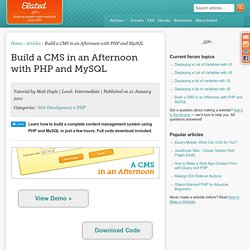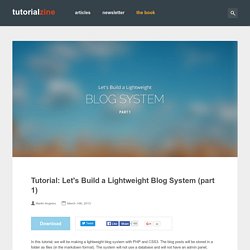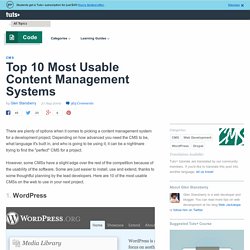

Getting started with the Content Management System. Getting started with the Content Management System WYSIWYG Web Builder has a built-in (PHP based) Content Management System to allow you or your customers to manage content online.

The basic idea is that the content of the page will be displayed inside a fixed area on the page, this is the CMS View. You can think of this as a frame or content place holder, although the content will be dynamically merged with the rest of the page when the page is requested from the server. Server. Standard WYSIWYG Web Builder tools. Server, so you don't have to fill the menus manually.
Key features: • Online administrator panel to add/edit/copy and remove pages. • The administrator panel supports several popular editors like CKEditor, TinyMCE and CLEditor. . • You can hide pages from the menu structure which are currently under construction. • Uses several individual 'design blocks' to give maximum flexibility so you can easily integrate the tools into your existing layouts. CMS with Dreamweaver CS4, PHP, MySQL and CKEditor (4 of 45)
Build a CMS in an Afternoon with PHP and MySQL. You're now ready to build the Article PHP class.

This is the only class in our CMS, and it handles the nitty-gritty of storing articles in the database, as well as retrieving articles from the database. Once we've built this class, it will be really easy for our other CMS scripts to create, update, retrieve and delete articles. Inside your cms folder, create a classes folder. Inside that classes folder, create a new file called Article.php, and put the following code into it: This file is quite long, but it's fairly simple stuff when you break it down. Everything after these lines of code — up until the closing brace at the end of the file — contains the code that makes up the Article class.
After starting our class definition, we declare the properties of the class: $id, $publicationDate, and so on.
Tutorial: Let’s Build a Lightweight Blog System (part 1) Martin Angelov In this tutorial, we will be making a lightweight blog system with PHP and CSS3.

The blog posts will be stored in a folder as files (in the markdown format). The system will not use a database and will not have an admin panel, which makes it perfect for small blogs with only one author. It will have an RSS feed and a JSON read-only API, and will feature a completely responsive design that adapts to the screen size of the device. In this first part, we are going to write the PHP backend, and in part 2, we will code the HTML and CSS. The posts Posts will be named in the following pattern: 2013-03-14_url-of-the-post.md and they will be stored in the posts/ folder. Each post will be in the markdown format (hence the extension) . # The title of the blog post Body of the blog post.
This will make the first line a H1 heading. What is markdown Markdown is a lightweight format for writing text. We can’t simply display the raw markdown directly, first we have to transform it into HTML. Tutorial: Let’s Build a Lightweight Blog System (part 1) DynPage - A simple Content Management System based on CKeditor. Top 10 Most Usable Content Management Systems. There are plenty of options when it comes to picking a content management system for a development project.

Depending on how advanced you need the CMS to be, what language it's built in, and who is going to be using it, it can be a nightmare trying to find the "perfect" CMS for a project. However, some CMSs have a slight edge over the rest of the competition because of the usability of the software. Some are just easier to install, use and extend, thanks to some thoughtful planning by the lead developers. Here are 10 of the most usable CMSs on the web to use in your next project. What is there left to say about WordPress that hasn't already been said? And super-quick installation wizard. For those users not familiar with HTML or other markup language, a WYSIWYG editor is provided straight out of the box. For developers, the theming language is fairly simple and straightforward, as well the Plugin API.